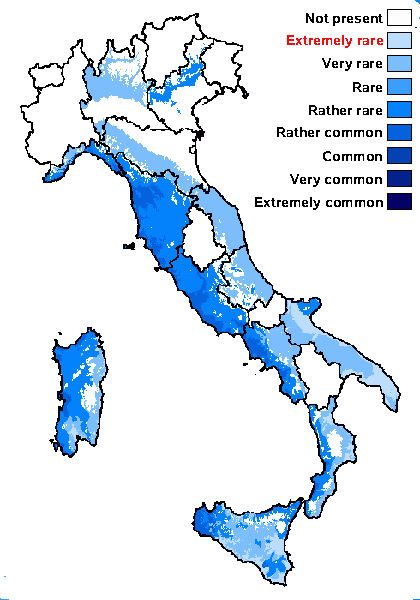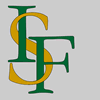Solenopsora grisea (Bagl.) Kotlov
Nov. Sist. Niz. Rast., 37: 251, 2004. Basionym: Ricasolia cesatii var. grisea Bagl. - Comm. Soc. Critt. Ital., 1, 3: 121, 1862.
Synonyms: Solenopsora bagliettoana Tav. ined.
Distribution: N - VG (Guttová & al. 2019, Senko & al. 2024), Ven (Guttová & al. 2012), Lomb (Guttová & al. 2012). Emil (Fariselli & al. 2020), Lig (Guttová & al. 2014, 2019, Senko & al. 2024). C - Tosc (Guttová & al. 2014, 2019, Darmostuk & al. 2022), Marc (Nimis & Tretiach 1999, Guttová & al. 2019, Senko & al. 2024), Abr (Guttová & al. 2019, Senko & al. 2024), Laz (Nimis & Tretiach 2004, Guttová & al. 2019, Senko & al. 2024), Sar (Guttová & al. 2019, Senko & al. 2024). S - Camp (Nimis & Tretiach 2004, Guttová & al. 2019, Senko & al. 2024), Pugl (Nimis & Tretiach 1999, Guttová & al. 2019, Senko & al. 2024), Cal (Puntillo 1996, Guttová & al. 2019, Senko & al. 2024), Si (Nimis & al. 1994, Guttová & al. 2019, Darmostuk & al. 2022, Senko & al. 2024).
Description: Thallus crustose-placodioid, episubstratic, forming continuous, irregular, up to 8-10 cm wide patches, the central parts glaucous grey-green, the marginal lobes up to 1 mm wide, white-pruinose at margins and at tips. Central part of thallus with raised lobules producing blastidia or breaking into soralia-like structures. Apothecia infrequent, lecanorine, up to 1.5 mm across, with an initially flat, then strongly convex, brown, pruinose or epruinose disc and a crenulate, then often excluded thalline margin. Epithecium brownish; hymenium colourless, 60-70 µm high, K/I+ blue; paraphyses simple, coherent; hypothecium colourless, 80-100 µm high. Asci 8-spored, cylindrical-clavate, with a K/I+ blue outer coat and a K/I+ uniformly blue apical dome, approaching the Catillaria-type. Ascospores (0-)1-septate, hyaline, narrowly ellipsoid, (10-)14-18 x 2.5-4 µm. Photobiont chlorococcoid. Spot tests: cortex and medulla C-, K-, KC-, P- or rarely P+ faintly yellow. Chemistry: medulla with terpenoids and unidentified substances, rarely with atranorin.Note: on calcareous rocks in open to sheltered situations; for further details see Guttová & al. (2014).
Growth form: Crustose placodiomorph
Substrata: rocks
Photobiont: green algae other than Trentepohlia
Reproductive strategy: mainly asexual, by soredia, or soredia-like structures (e.g. blastidia)
Most common in areas with a humid-warm climate (e.g. most of Tyrrenian Italy)
Commonnes-rarity: (info)
Alpine belt: absent
Subalpine belt: absent
Oromediterranean belt: absent
Montane belt: absent
Submediterranean belt: very rare
Padanian area: absent
Humid submediterranean belt: rather rare
Humid mediterranean belt: rather common
Dry mediterranean belt: extremely rare

Predictive model
Herbarium samples


P.L. Nimis; Owner: Department of Life Sciences, University of Trieste
Herbarium: TSB (30712)
2001/12/18

Courtesy Danièle et Olivier Gonnet - Source: https://www.afl-lichenologie.fr/Photos_AFL/Photos_AFL_S/Text_S2/Solenopsora_grisea.htm
France, session AFL Lubéron 2009 - Vaucluse
Growth form: Crustose placodiomorph
Substrata: rocks
Photobiont: green algae other than Trentepohlia
Reproductive strategy: mainly asexual, by soredia, or soredia-like structures (e.g. blastidia)
Most common in areas with a humid-warm climate (e.g. most of Tyrrenian Italy)
Commonnes-rarity: (info)
Alpine belt: absent
Subalpine belt: absent
Oromediterranean belt: absent
Montane belt: absent
Submediterranean belt: very rare
Padanian area: absent
Humid submediterranean belt: rather rare
Humid mediterranean belt: rather common
Dry mediterranean belt: extremely rare

Predictive model
| Herbarium samples |


P.L. Nimis; Owner: Department of Life Sciences, University of Trieste
Herbarium: TSB (30712)
2001/12/18

 INDEX FUNGORUM
INDEX FUNGORUM
 GBIF
GBIF
 DOLICHENS
DOLICHENS











